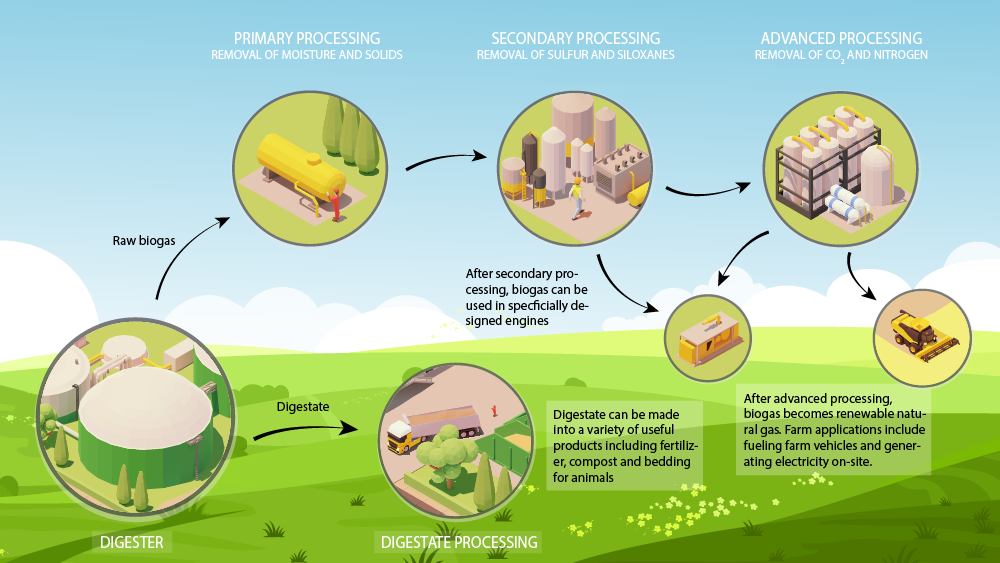What are the low-carbon fuels?
By Aytek Yuksel, Content Marketing Leader - Power Systems

Many businesses have made it a priority to reduce their carbon footprint. Multiple ways to reduce carbon dioxide (CO2) emissions are available to business owners.
One is to purchase carbon offsets—pay someone else to reduce emissions on your behalf. Another is to use less energy, for example, have employees travel less often, or by improving the energy efficiency of a building. Using low-carbon and alternative fuels is a third option which has become viable for an increasing number of businesses. Low-carbon fuels can be used as a substitute for traditional fossil fuels in many applications. For example, vehicles of all types, including personal cars, trucks, off-road vehicles, ships, and more can run on low-carbon fuels. Purchasing electricity made from low-carbon fuels or renewable energies is also a way to reduce a business’ carbon footprint.
Are natural gas and propane low-carbon fuels?
That’s right—despite their fossil origin, natural gas and propane are low-carbon fuels—in comparison to traditional alternatives. Both have a lower emission factor than gasoline and diesel. This means that burning a certain amount or natural gas or propane will release less CO2 than burning the equivalent amount of gasoline or diesel. Fuels with higher carbon contents release more CO2 when they are burned. Natural gas consists primarily of methane. One molecule of methane contains a single atom of carbon. As a result, methane has a lower carbon-to-energy content than other fossil fuels.
Engines used as mechanical drives in oilfield operations are prime candidates for natural gas operation. Oil wells almost always produce natural gas in addition to oil. When an extraction site doesn't have infrastructure to collect and transport the available natural gas, the unwanted natural gas is flared. Instead, using this excess natural gas an alternative to diesel for the mechanical drives saves money, reduces emissions, and helps secure the fuel supply.
Conversions of coal-fired power-plants to natural gas are also a major trend in the power generation sector. You may have read about a local coal power-plant closing? Chances are, it’s being replaced with a natural gas-fired combined cycle power plant.
What are CNG, LNG, LPG; are they low-carbon fuels?
Tractor-trailers, hauler trucks, dumpster trucks, buses and other commercial vehicles, and even ships can be converted to run on either compressed natural gas (CNG), liquefied natural gas (LNG), or liquefied petroleum gas (LPG, a form of propane).
This allows the owner to lower the emissions of the converted vehicles without breaking the bank. With the right use case, fuel conversions also provide several other benefits. You can read more about these benefits of alternative fuels and fuel-flexibility.
What are biogas and renewable natural gas?
Gaseous hydrocarbons can also be readily produced from biomass. Like renewable diesel and biodiesel, these fuels are CO2-neutral. Significant amounts are created through natural fermentation in bogs and in the digestive tract of mammals, particularly cows. Bacteria eat organic matter, breaking it down and releasing methane, CO2 and hydrogen sulfide. The resulting gas is known as biogas.
Biogas is also an unintentional product of fermentation occurring in landfills. In the United States, landfills are required to collect biogas to prevent its emission into the atmosphere. The requirement exists because methane, when it is not burned, is a much stronger greenhouse gas than CO2. While some landfills flare off the collected biogas, others use it productively. Biogas can be used as-is in specially designed internal combustion engines to generate electricity. More simply, it can be burned in a furnace or a boiler for heat.

In certain use-cases, biogas can also have negative carbon intensity value. This is because the capture and productive use of biogas prevents carbon emissions.
It is also possible to separate the methane from the other, unwanted constituents. Renewable natural gas is then obtained. Renewable natural gas is fully interchangeable with natural gas and can be injected into natural gas pipelines or used on its own.
Biogas and natural gas are also produced industrially at wastewater treatment plants and livestock operations. Most commonly, biomass-sewage sludge or cow manure-is fermented in large tanks known as digesters, generating biogas. To promote fermentation, the digesters can be heated using waste heat from biogas-fueled on-site generators-a classical use case for combined heat and power. According to the U.S. Department of Energy, about 1,300 wastewater treatment plants in the United States produce biogas by fermentation and use it on-site.
Running gas generators on biogas or renewable natural gas is a great way to produce CO2 free electricity from renewable resources. Contrary to renewable electricity produced by solar panels and wind turbines, which is inherently variable, renewable electricity produced in a generator using biogas and renewable natural gas is available on-demand. This makes biogas and renewable gas great decarbonization options for facilities which require an always-available source of power on-site for backup, prime or continuous power purposes. This is why many data centers, hospitals, industrial facilities and more are exploring or investing in biogas and renewable gas generators.
What is hydrotreated vegetable oil; is it renewable diesel?
Diesel-like fuels can be manufactured without the use of any fossil resources. Hydrotreated Vegetable Oil (HVO) is one common type. HVO is obtained by processing lipids such as vegetable oil, tallow or used cooking oil, which is made of paraffinic hydrocarbon. The fuel is derived from the same feedstocks used to produce biodiesel. However, instead of using the transesterification process, HVO is produced via the hydrotreated process. HVO is sometimes referred to as renewable diesel, or green diesel.
What is biodiesel; is biodiesel a low-carbon fuel?
Biodiesel is a distinct fuel. It is made using a chemical process known as transesterification. The transesterification process results in molecules called fatty acid methyl esters, or FAME. Biodiesel consist primarily of these FAME molecules. Fuels meeting the industry standard for renewable diesel can be used as drop-in replacements for fossil diesel. Biodiesels, in contrast, must be blended with fossil diesel to be used in most vehicles.
When renewable diesel and biodiesel burn, they merely return carbon to the atmosphere—the same carbon atoms that the plants used as feedstock withdrew from the atmosphere. They are, accordingly, net-CO2 free fuels, or CO2-neutral.
What are power-to-x and e-fuels?
This is a rapidly emerging category of synthetic low-carbon or no-carbon fuels. E-fuels are manufactured from inorganic feedstock, primarily CO2 and water, using renewable electricity, such as solar, wind, or hydropower. The category includes a variety of hydrocarbon fuels such as e-methanol, e-diesel and e-methane, as well as non-hydrocarbon fuels such as ammonia. Don’t forget to check out what are power-to-x and e-fuels with more details and examples.
What about hydrogen?
Hydrogen burns without releasing any carbon. Not all hydrogen, however, is low-carbon. Most hydrogen produced in the world today is manufactured via the steam methane reforming process. This process uses methane as a feedstock and generates a lot of CO2 (unless the methane feedstock is coming from biogas, in which case the process is CO2-neutral).
Another process, electrolysis, allows to produce hydrogen from water. Electrolysis is energy-intensive, but when it is conducted using renewable electricity, the result is fully CO2-free hydrogen, or "green hydrogen."
A variety of applications that use green hydrogen are commercially available or in development stages, including locomotives, personal vehicles, gas turbines, internal combustion generators, and more. Green hydrogen can also be used as a feedstock for other e-fuels.
Finding the right alternative fuel for your business
You went through a range of alternative and low-carbon fuels. As you seek to fulfill the needs of your business, it is important to remember there is not a one-size fits all answer.
Beyond the fuel itself, here are a few others you can take into consideration in finding the right fit for your business: Availability of these fuels across your locations, the local regulations your equipment needs to comply with, and your specific use case.
As you have noticed, these additional considerations are more local and unique to your business. You can access more information and discuss these further by reaching out to a partner local to your business.
Author Profiles

Aytek Yuksel, Content Marketing Leader - Power Systems
Aytek is a marketing leader at Cummins, focusing on technology and thought leadership. Since joining in 2008, he has held various marketing roles and now shares insights on markets, technologies, and energy transition. Aytek lives in Minneapolis with his wife and two kids.